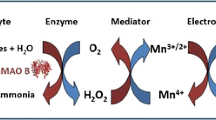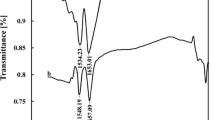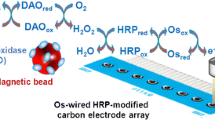Abstract
An electrochemical sensor for palytoxin (PlTX) detection, based on a strip of eight screen-printed electrodes connected to a cost-effective and portable apparatus, is reported. Sheep erythrocytes were used to test the palytoxin detector and degree of haemolysis was evaluated by measuring release of the cytosolic lactate dehydrogenase (LDH). Percentage haemolysis and, therefore, the amount of LDH measured, by use of NADH/pyruvate and appropriate electrochemical mediators, was correlated with the concentration of the toxin. Two different electrochemical approaches were investigated for evaluation of LDH release, but only one based on the use of a binary redox mediator sequence (phenazine methosulfate in conjugation with hexacyanoferrate(III)) proved useful for our purpose. After analytical and biochemical characterization, the sensor strip was used to measure palytoxin. Sheep blood and standard solutions of PlTX were left to react for two different incubation times (24 h or 4 h), resulting in working ranges of 7 × 10−3–0.02 ng mL−1 and 0.16–1.3 ng mL−1, respectively. The specificity of the test for palytoxin was evaluated by use of ouabain, which acts in the same way as PlTX on the Na+/K+-ATPase pump. A cross-reactivity study, using high concentrations of other marine biotoxins was also conducted. Experiments to evaluate the matrix effect and recovery from mussels are discussed.

ᅟ






Similar content being viewed by others
References
Usami M, Satake M, Ishida S, Inoue A, Kan Y, Yasumoto T (1995) Palytoxin analogs from the dinoflagellates Ostreopsis siamensis. J Am Chem Soc 117:5389–5390
Rhodes L (2011) World-wide occurrence of the toxic dinoflagellate genus Ostreopsis Schmidt. Toxicon 57:400–407
Ciminiello P, Dell’aversano C, Fattorusso E, Forino M, Tartaglione L, Grillo C, Melchiorre N (2007) Putative palytoxin and its new analogue, ovatoxin-a, in Ostreopsis ovate collected along the Ligurian coasts during the 2006 toxic outbreak. J Am Soc Mass Spectrom 19:111–120
Riobò P, Franco JM (2010) Palytoxins: Biological and chemical determination. Toxicon 57:368–375
Wiles JS, Vick JA, Christensen MK (1974) Toxicological evaluation of palytoxin in several animal species. Toxicon 12:427–433
Sosa S, Del Favero G, De Bortoli M, Vita F, Soranzo MR, Beltramo D, Ardizone M, Tubaro A (2009) Palytoxin toxicity after acute oral administration in mice. Toxicol Lett 191:253–259
Durando P, Ansaldi F, Oreste P, Moscatelli P, Marensi L, Grillo C, Gasparini R, Icardi G (2007) Ostreopsis ovata and human heath: epidemiological and clinical features of respiratory syndrome outbreaks from a two-year syndromic surveillance, 2005–2006 in north-west Italy. Euro Surveill 12:191–193
Aligizaki K, Katikou P, Nikolaidis G, Panou A (2008) First episode of shellfish contamination by palytoxin-like compounds from Ostreopsis species (Aegean Sea, Greece). Toxicon 51:418–427
Artigas P, Gadsby DC (2003) Na+/K+-pump ligands modulate gating of palytoxin-induced ion channels. Proc Natl Acad Sci U S A 100(2):501–505
Gazzetta Ufficiale della Repubblica Italiana n (2002) 165, 16 May pp 16–19
CRLMB (2009) EU Harmonised Standard Operating Procedure for detection of lipophilic toxins by mouse biomassay. Version 5, June
EFSA (2009) Scientific opinion on marine biotoxins in shellfish-Palytoxin group. EFSA J 7(12):1–38, 1393
Bignami GS (1993) A rapid and sensitive haemolysis neutralization assay for palytoxin. Toxicon 31:817–820
Riobó P, Paz B, Franco JM, Vazquez JA, Murado MA (2008) Proposal for a simple and sensitive haemolytic assay for palytoxin. Toxicological dynamics, kinetics, ouabain inhibition and thermal stability. Harmful Algae 7:415–429
Bellocci M, Ronzitti G, Milandri A, Melchiorre N, Grillo C, Poletti R, Yasumoto T, Rossini GP (2008) A cytolytic assay for the measurement of palytoxin based on a cultured monolayer cell line. Anal Biochem 374:48–55
Ledreux A, Krys S, Bernard C (2009) Suitability of the neuro-2a cell line for the detection of palytoxin and analogue (neurotoxic phycotoxin). Toxicon 53:300–308
Espina B, Cagide E, Louzao C, Fernandez MM, Vieytes MR, Katikou P, Villard A, Jaen D, Maman L, Botana LM (2009) Specific and dynamic detection of palytoxins by in vitro microplate assay with human neuroblastoma cells. Biosci Rep 29(1):13–23
Riobó P, Paz B, Franco JM (2006) Analysis of palytoxin-like in Ostreopsis cultures by liquid chromatography with precolumn derivatization and fluorescence detection. Anal Chim Acta 566(2):217–223
Lenoir S, Ten-Hage L, Turquet J, Quod JP, Bernard C, Hennion MC (2004) First evidence of palytoxin analogues from an Ostreopsis mascarenensis (Dinophyceae) benthic bloom in Southwestern Indian Ocean. J Phycol 40(6):1042–1051
Ciminiello P, Dell’Aversano C, Fattorusso E, Forino E, Magno GS, Tartaglione L, Grillo C, Melchiorre N (2006) The Genoa 2005 Outbreak. Determination of putative palytoxin in Mediterranean Ostreopsis ovata by a new liquid chromatography tandem mass spectrometry method. Anal Chem 78:6153–6159
Ciminiello P, Dell’Aversano C, Dello Iacovo E, Fattorusso E, Forino M, Tartaglione L, Rossi R, Soprano V, Capozzo D, Serpe L (2011) Palytoxin in seafood by liquid chromatography tandem mass spectrometry: investigation of extraction efficiency and matrix effect. Anal Bioanal Chem 401:1043–1050
Hart JP, Crew A, Crouch E, Honeychurch C, Pemberton RM (2007) In: Alegret S, Merkocy A (eds) Comprehensive Analytical Chemistry. London, Elsevier
Ricci F, Amine A, Palleschi G, Moscone D (2003) Prussian blue based screen printed biosensors with improved characteristics of long-term lifetime and pH stability. Biosens Bioelectron 18:165–174
Amine A, Kauffmann JM (1992) Preparation and characterization of a fragile enzyme immobilized carbon paste electrode. Bioelectrochem Bioenerg 28:117–125
Decker T, Lohmann-Matthes ML (1988) A quick and simple method for the quantitation of lactate dehydrogenase release in measurements of cellular cytotoxicity and tumor necrosis factor (TNF) activity. J Immunol Methods 15:61–69
Cagnini A, Palchetti I, Lionti I, Mascini M, Turner APF (1995) Disposable ruthenised screen printed biosensors for pesticides monitoring. Sensor Actuat B 24–25:85–95
Milandri A, Ceredi A, Riccardi E, Gasperetti L, Susini F, Casotti M, Faiman L, Pigozzi S (2012) Proceedings of the 14th International Conference on Harmful Algae. International Society for the Study of Harmful Algae and Intergovernmental Oceanographic Commission of UNESCO
Kopperschlager G, Kirchberger J (1996) Methods for the separation of lactate dehydrogenases and clinical significance of the enzyme. J Chromatogr, B 684:25–49
Desagher S, Glowinski J, Premont J (1997) Pyruvate protects neurons against hydrogen peroxide-induced toxicity. J Neurosci 17(23):9060–9067
Arduini F, Amine A, Majorani C, Di Giorgio F, De Felice D, Cataldo F, Moscone D, Palleschi G (2010) High performance electrochemical sensor based on modified screen-printed electrodes with cost-effective dispersion of nanostructurated carbon black. Electrochem Commun 12:346–350
Volpe G, Cotroneo E, Moscone D, Croci L, Cozzi L, Ciccaglioni G, Palleschi G (2009) A bienzyme electrochemical probe for flow injection analysis of okadaic acid based on protein phosphatase-2A inhibition: An optimization study. Anal Biochem 385:50–56
Amzil Z, Sibat M, Chomerat N, Grossel H, Marco-Miralles F, Lemee R, Nezan E, Sechet V (2012) Ovatoxin-a and palytoxin accumulation in seafood in relation to Ostreopsis cf. ovate blooms on the French Mediterranean coast. Mar Drugs 10:477–496
Acknowledgements
The authors wish to thank projects RF-IZI-2008-1139874 “Algal toxins contaminating water and fish products of Italian fresh and marine waters: monitoring, characterization and study of innovative methods” and FP7-Ocean 2013, proposal SMS n. 613844, for financial support. We gratefully thank Dr Nancy Downer for her suggestions and skilful collaboration in revising the English manuscript.
Author information
Authors and Affiliations
Corresponding author
Rights and permissions
About this article
Cite this article
Volpe, G., Cozzi, L., Migliorelli, D. et al. Development of a haemolytic–enzymatic assay with mediated amperometric detection for palytoxin analysis: application to mussels. Anal Bioanal Chem 406, 2399–2410 (2014). https://doi.org/10.1007/s00216-014-7630-1
Received:
Revised:
Accepted:
Published:
Issue Date:
DOI: https://doi.org/10.1007/s00216-014-7630-1




